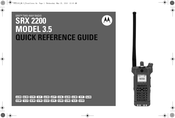Motorola SRX 2200 3.5 Manuals
Manuals and User Guides for Motorola SRX 2200 3.5. We have 3 Motorola SRX 2200 3.5 manuals available for free PDF download: User Manual, Quick Reference Manual
Motorola SRX 2200 3.5 User Manual (159 pages)
APX TWO-WAY RADIOS
Brand: Motorola
|
Category: Two-Way Radio
|
Size: 2 MB
Table of Contents
-
-
Radio Care14
-
-
Status Icons33
-
Alert Tones39
-
-
-
Contacts61
-
Scan Lists66
-
Scan68
-
Recent Calls71
-
Quik Call II74
-
Fall Alert82
-
Logging out86
-
Hear Clear102
-
Radio Lock102
-
Radio Stun104
-
Using Radio Stun105
-
Radio Kill105
-
Radio Inhibit106
-
Location106
-
Location Format107
-
MGRS Coordinates108
-
Smartconnect116
-
Site Search117
-
Holster Sensor122
-
Wi-Fi130
-
Utilities131
-
Transmit Inhibit140
-
-
Disclaimer149
-
Limited Warranty156
Advertisement
Motorola SRX 2200 3.5 User Manual (210 pages)
Brand: Motorola
|
Category: Two-Way Radio
|
Size: 17 MB
Table of Contents
-
Disclaimer19
-
Securenet21
-
Home Button37
-
Keypad37
-
Status Icons43
-
Alert Tones52
-
Contacts75
-
Scan Lists81
-
Scan84
-
Man down93
-
Sending a Query115
-
Security123
-
Radio Lock123
-
Radio Stun126
-
Radio Kill127
-
GPS Operation128
-
Re-Pair Timer143
-
Wi-Fi164
-
Utilities165
-
Transmit Inhibit177
-
Helpful Tips182
-
Radio Care182
-
Battery Care189
-
Accessories191
-
Glossary196
-
Limited Warranty202
Motorola SRX 2200 3.5 Quick Reference Manual (48 pages)
Brand: Motorola
|
Category: Two-Way Radio
|
Size: 10 MB
Table of Contents
Advertisement


